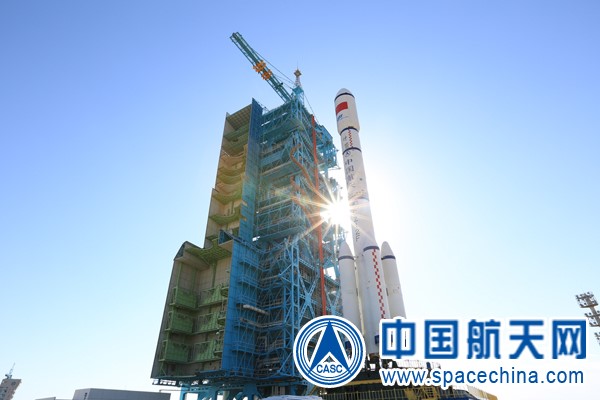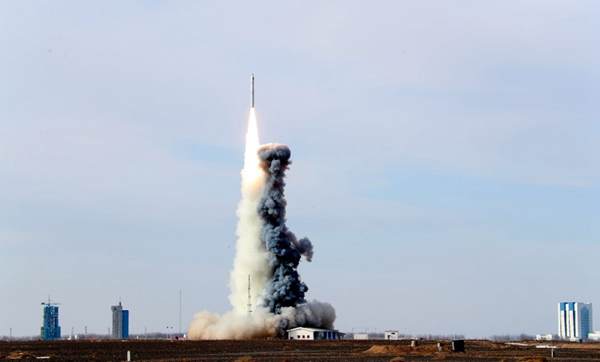

China is planning more launches of Long March rockets than ever in 2018 as the 36 missions on the agenda constitute the lion’s share of the country’s space program efforts.

The Long March-2F carrier rocket that was used to carry China's second space lab, Tiangong-2. (Photo from spacechina.com)
The series will be tasked with missions including sending BeiDou satellites into space to form a network for the domestic BeiDou navigation satellite and launching the Chang'e-4 lunar probe, said Li Hong, director of the China Academy of Launch Vehicle Technology, a subordinate of China Aerospace Science and Technology Corporation (CASC).
Of the 36 planned missions, 14 will be carried out by Long March-3A rockets and six by Long March-2C series, according to Li, a member of the 13th National Committee of the Chinese People's Political Consultative Conference, which opened its annual session on March 3 in Beijing.
The Long March-3A series, which is usually used to carry navigation and communications satellites, will launch 14 times this year, with 10 carrying BeiDou navigation and positioning satellites, Li said, adding that 8 of the 10 missions would put twin satellites into orbit.

The Long March-11 rocket, a solid propellant carrier developed by China Academy of Launch Vehicle Technology, a division of China Aerospace Science and Technology Corporation (CASC), succeeded in sending six small satellites into orbit from Jiuquan Satellite Launch Center in Northwest China. (Photo by Xie Shangguo from People’s Daily Online)
According to the schedule, Long March-3A carriers need to send 18 BeiDou satellites into space by the end of 2018 so that the BeiDou system will be able to provide navigation and positioning services to countries along OBOR. The carrier is lined up for 40 launches from 2018 to 2020.
The Long March-8 series China is now developing is expected to have its maiden flight in 2020 as the work on its prototype has begun, the director said, elaborating that this new medium-lift carrier rocket is projected to fill China’s blank by increasing its payload capabilities for solar-synchronous orbit from 3 to 4.5 tons.
Launches of the Long March-5 series, with the strongest payload capability among Chinese carriers, have been scheduled for the latter half of this year in preparation for China's manned space, lunar probe and Mars probe missions.
 Fire brigade in Shanghai holds group wedding
Fire brigade in Shanghai holds group wedding Tourists enjoy ice sculptures in Datan Town, north China
Tourists enjoy ice sculptures in Datan Town, north China Sunset scenery of Dayan Pagoda in Xi'an
Sunset scenery of Dayan Pagoda in Xi'an Tourists have fun at scenic spot in Nanlong Town, NW China
Tourists have fun at scenic spot in Nanlong Town, NW China Harbin attracts tourists by making best use of ice in winter
Harbin attracts tourists by making best use of ice in winter In pics: FIS Alpine Ski Women's World Cup Slalom
In pics: FIS Alpine Ski Women's World Cup Slalom Black-necked cranes rest at reservoir in Lhunzhub County, Lhasa
Black-necked cranes rest at reservoir in Lhunzhub County, Lhasa China's FAST telescope will be available to foreign scientists in April
China's FAST telescope will be available to foreign scientists in April "She power" plays indispensable role in poverty alleviation
"She power" plays indispensable role in poverty alleviation Top 10 world news events of People's Daily in 2020
Top 10 world news events of People's Daily in 2020 Top 10 China news events of People's Daily in 2020
Top 10 China news events of People's Daily in 2020 Top 10 media buzzwords of 2020
Top 10 media buzzwords of 2020 Year-ender:10 major tourism stories of 2020
Year-ender:10 major tourism stories of 2020 No interference in Venezuelan issues
No interference in Venezuelan issues
 Biz prepares for trade spat
Biz prepares for trade spat
 Broadcasting Continent
Broadcasting Continent Australia wins Chinese CEOs as US loses
Australia wins Chinese CEOs as US loses